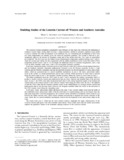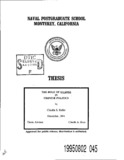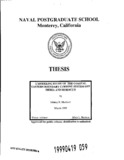Modeling Studies of the Leeuwin Current off Western and Southern Australia
| dc.contributor.author | Batteen, Mary L. | |
| dc.contributor.author | Butler, Christopher L. | |
| dc.date.accessioned | 2014-09-29T16:46:58Z | |
| dc.date.available | 2014-09-29T16:46:58Z | |
| dc.date.issued | 1998-11 | |
| dc.identifier.citation | Journal of Physical Oceanography, November 1998 | |
| dc.identifier.uri | https://hdl.handle.net/10945/43391 | |
| dc.description.abstract | The Leeuwin Current strengthens considerably from February to May each year, following the slackening of southerly coastal winds; strong eddies develop. A high-resolution, multilevel, primitive equation ocean model is used to examine this eddy development in an idealized way, by considering the development of flow from rest when temperatures are initially given the observed longshore gradients. The system is allowed to geostrophically adjust in the absence of longshore winds and of any surface heat flux. Two types of experiments are conducted. The first type uses the Indian Ocean climatological temperature gradient forcing (case 1 and 2), while the second type repeats the first experiment with the added contribution of the North West Shelf (NWS) temperature profile (cases 3 and 4). To investigate the additional effects of coastline irregularities, cases 1 and 3 use an ideal coastline, while cases 2 and 4 use an irregular (realistic) coastline. In all cases, maximum surface velocities occur at Cape Leeuwin, where the Leeuwin Current changes direction, and off Southern Australia. Maximum undercurrent velocities occur off Western Australia. In case 1, Cape Leeuwin and the Western Australian coast are the preferred locations for the development of warm, anticyclonic eddies, which are generated due to a mixed instability mechanism. In case 2, the warm, anticyclonic eddies occur in the vicinity of coastal promontories and at Cape Leeuwin. While advection of warm water is present along the entire coast in case 1, the irregular coastline geometry limits the extent of warm water in case 2. The added contribution from the NWS water in cases 3 and 4 augments the onshore geostrophic inflow to produce a model Leeuwin Current and undercurrent that are more vigorous and unstable than in the previous cases. In case 3, the NWS water adds strong horizontal shear to the coastal equatorial region of the domain and vertical shear to the inshore current. It also advects warmer water along the entire coast. In case 4, the addition of both the NWS water and the irregular coastline results in the establishment of a stronger surface current and undercurrent than in the previous cases; however, the irregular coastline limits the extent of the advection of the NWS warmer water along the Australian coast. | en_US |
| dc.rights | This publication is a work of the U.S. Government as defined in Title 17, United States Code, Section 101. Copyright protection is not available for this work in the United States. | en_US |
| dc.title | Modeling Studies of the Leeuwin Current off Western and Southern Australia | en_US |
| dc.type | Article | en_US |
| dc.contributor.department | Oceanography |





